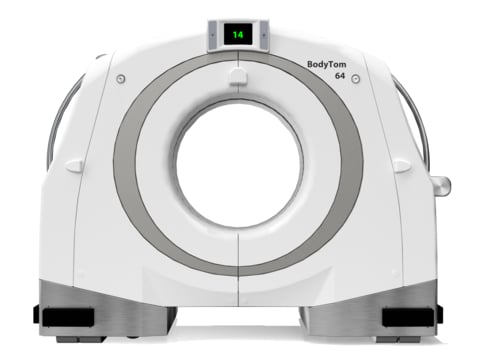
The world’s first computed tomography (CT) scan was performed in 1971 on a patient at Atkinson Morley Hospital in Wimbledon, now part of St George’s Hospital. It was a brain scan performed by Sir Godfrey Hounsfield under the supervision of Jamie Ambrose, MD, a consultant neuroradiologist who happened to be looking for less painful alternatives to existing methods of examining the brain.1, 2
CT technology has come a long way since its inception in the 1970s. This medical imaging technique, which uses X-rays and advanced computer algorithms to create detailed cross-sectional images of the body, has helped revolutionize diagnostics and treatment planning. Its technology continues to advance at a rapid pace, and according a recent report conducted by Mordor Intelligence, a market research company, the CT market size is expected to grow from $8.14 billion in 2023 to $10.95 billion by 2028, at a CAGR of 6.12% during the forecast period of 2023-2028.3 Here is a look at some of the technological advancements taking place in today’s market.
Enhanced Resolution and Speed
One of the most anticipated developments in CT technology has been the improvement in resolution and speed. As computational power and software algorithms continue to advance, CT scanners are expected to produce even more detailed images in a shorter amount of time. This will not only benefit patient comfort but also enable more precise diagnoses, particularly for conditions that require capturing dynamic processes within the body.
Reduced Radiation Dose
Safety concerns surrounding radiation exposure have driven research into reducing the radiation dose delivered during CT scans. Predictions suggest that future CT scanners will be designed to provide exceptional image quality with significantly lower radiation doses, minimizing the risks associated with frequent or repeated scans.
Reducing radiation exposure is a significant concern in CT imaging. Low-dose CT techniques and technologies, such as iterative reconstruction algorithms and automatic exposure control, have been developed to minimize radiation dose while maintaining image quality. This trend is expected to continue with a focus on dose optimization.
Artificial Intelligence Integration
Artificial intelligence (AI) is set to play a pivotal role in the evolution of CT technology. AI algorithms can assist radiologists in image interpretation, automating routine tasks such as organ segmentation, tumor detection and anomaly identification. This integration of AI will not only improve diagnostic accuracy, but also increase efficiency, potentially reducing healthcare costs.
In May, Philips launched the Philips CT 3500, a new high-throughput CT system targeting the needs of routine radiology and high-volume screening programs. It is powered by AI and includes a range of image-reconstruction and workflow-enhancing features that help to deliver the consistency, speed and first-time-right image quality needed for confident diagnoses by clinicians, and increased return on investment.
“Increased financial pressures, chronic staff shortages and escalating patient demand are driving radiology departments to do everything they can to maximize throughput, to guarantee equipment uptime and to avoid repeat scans,” said Frans Venker, General Manager Computed Tomography at Philips, in a written statement. He added, “Today, many radiology departments scan hundreds of patients a day. We’ve engineered the Philips CT 3500 to reduce the pain points that these high-volume departments face by developing a versatile, reliable, high-throughput imaging solution. It automates radiographers’ most time-consuming steps so that they can spend more time focusing on the patient.”
Portable and Point-of-care CT
Advancements in miniaturization and portable technology will likely lead to the development of compact, point-of-care CT scanners. These devices could be used in emergency rooms, ambulances and even remote locations, providing quick access to diagnostic imaging in critical situations.
Last November, NeuroLogica’s head-to-toe trauma imaging solution, the BodyTom 64 Point-of-Care Mobile Computed Tomography Scanner, received 510(k) clearance from the U.S. Food and Drug Administration for commercial use in the United States. Based on customer feedback, the company designed the BodyTom 64 to enhance the user experience and improve clinical workflows through revisions to both the software and the data acquisition system. Revisions included incorporating Linux as the operating system and having the ability to generate up to 64 cross-sectional CT images of a patient’s body, versus the 32 images produced by the predicate BodyTom Elite. The scanner has indications for both pediatric and adult imaging, and can be used for a variety of needs, bringing the power of innovative imaging to patients’ bedsides safely and efficiently.
Future-forward Technology
The future of CT technology holds immense promise for both healthcare providers and patients. With advancements in resolution, speed, radiation dose reduction, AI integration and personalized medicine, CT scans will continue to be a cornerstone of modern medical diagnostics. The shift toward functional and multimodal imaging, along with the development of portable CT scanners, will further extend the reach of this technology. As CT technology evolves, it will undoubtedly contribute to more accurate diagnoses, better treatment outcomes and improved patient care in the years to come.
View ITN's Computed Tomography Comparison Chart here
REFERENCES:
1. https://www.hbs.edu/ris/Publication%20Files/20-004_049f61d2-eb45-41b8-ad3e-97b6fa1d1934.pdf
2. Schulz RA, Stein JA, Pelc NJ. How CT happened.
J Med Imaging (Bellingham). 2021 Sep;8(5):052110. doi: 10.1117/1.JMI.8.5.052110. Epub 2021 Oct 29. PMID: 34729383; PMCID: PMC8555965.
3. https://www.mordorintelligence.com/industry-reports/global-ct-market-industry


 December 17, 2025
December 17, 2025 









